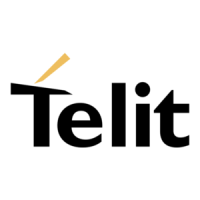LE910C1 Hardware User Guide
1VV0301298 Rev. 1.08 - 2017-11-14
Reproduction forbidden without written authorization by Telit Communications S.p.A. - All Rights Reserved
Telit Confidential Information, provided under NDA Page
56 of 119
Mode Average [Typical] Mode Description
3) Operative Mode (LTE)
LTE (0 dBm) 180mA
LTE CAT 1channel BW 5 MHz, RB=1, Tx = 0 dBm
(Test case: BAND 1, Channel 300)
LTE (0 dBm) 190mA
LTE CAT 1 channel BW 10 MHz, RB=1, Tx = 0 dBm
(Test case: BAND 1, Channel 300)
LTE (0 dBm) 210mA
LTE CAT 1 channel BW 5 MHz, RB=1, Tx = 0 dBm
With FTP TpT session LTE to USB
10Mbps DL/5Mbps UL
(Test case: BAND 1, Channel 300)
4) Operative Mode (WCDMA)
WCDMA Voice 200mA WCDMA voice call (Tx = 10 dBm)
WCDMA HSDPA (0 dBm) 150mA WCDMA data call (Cat 14, Tx = 0 dBm, Max throughput)
WCDMA HSDPA (22 dBm) 310mA WCDMA data call (Cat 14, Tx = 22 dBm, Max throughput)
5) Operative Mode (GSM)
GSM Tx and Rx mode
GSM900 PL5 250mA
GSM voice call
DCS1800 PL0 170mA
GPRS 4 Tx + 1 Rx
GSM900 PL5 430mA
GPRS Sending Data mode (CS-4)
DCS1800 PL0 340mA
6) Operative Mode (GPS)
GPS tracking 40mA
LTE connection is idle
* Worst/best case current values depend on network configuration - not under module control.
NOTE:
The electrical design for the power supply must ensure a peak current output of at least 2A.
NOTE:
In GSM/GPRS mode, RF transmission is not continuous, but is packed into bursts at a base
frequency of about 216 Hz with relative current peaks as high as about 2A. Therefore, the power
supply must be designed to withstand these current peaks without big voltage drops. This means
that both the electrical design and the board layout must be designed for this current flow.

